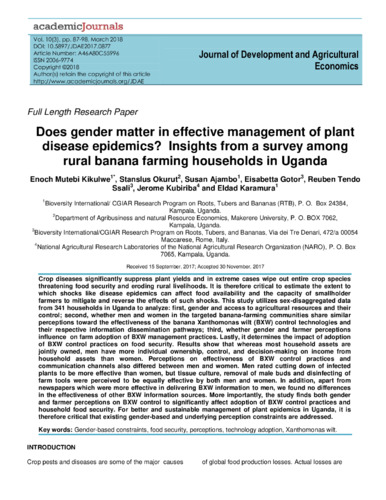Does gender matter in effective management of plant disease epidemics? Insights from a survey among rural banana farming households in Uganda
Abstract
Crop diseases significantly suppress plant yields and in extreme cases wipe out entire crop species threatening food security and eroding rural livelihoods. It is therefore critical to estimate the extent to which shocks like disease epidemics can affect food availability and the capacity of smallholder farmers to mitigate and reverse the effects of such shocks. This study utilizes sex-disaggregated data from 341 households in Uganda to analyze: first, gender and access to agricultural resources and their control; second, whether men and women in the targeted banana-farming communities share similar perceptions toward the effectiveness of the banana Xanthomonas wilt (BXW) control technologies and their respective information dissemination pathways; third, whether gender and farmer perceptions influence on farm adoption of BXW management practices. Lastly, it determines the impact of adoption of BXW control practices on food security. Results show that whereas most household assets are jointly owned, men have more individual ownership, control, and decision-making on income from household assets than women. Perceptions on effectiveness of BXW control practices and communication channels also differed between men and women. Men rated cutting down of infected plants to be more effective than women, but tissue culture, removal of male buds and disinfecting of farm tools were perceived to be equally effective by both men and women. In addition, apart from newspapers which were more effective in delivering BXW information to men, we found no differences in the effectiveness of other BXW information sources. More importantly, the study finds both gender and farmer perceptions on BXW control to significantly affect adoption of BXW control practices and household food security. For better and sustainable management of plant epidemics in Uganda, it is therefore critical that existing gender-based and underlying perception constraints are addressed.

